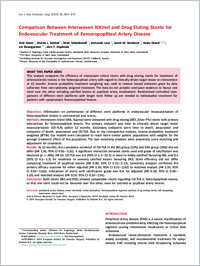Comparison Between Interwoven Nitinol and Drug Eluting Stents for Endovascular Treatment of Femoropopliteal Artery Disease.
- Haine A Division of Angiology, Swiss Cardiovascular Centre, Inselspital, Bern University Hospital, University of Bern, Bern, Switzerland.
- Schmid MJ Division of Angiology, Swiss Cardiovascular Centre, Inselspital, Bern University Hospital, University of Bern, Bern, Switzerland.
- Schindewolf M Division of Angiology, Swiss Cardiovascular Centre, Inselspital, Bern University Hospital, University of Bern, Bern, Switzerland.
- Lenz A CTU Bern, University of Bern, Bern, Switzerland.
- Bernhard SM Division of Angiology, Swiss Cardiovascular Centre, Inselspital, Bern University Hospital, University of Bern, Bern, Switzerland.
- Drexel H Division of Angiology, Swiss Cardiovascular Centre, Inselspital, Bern University Hospital, University of Bern, Bern, Switzerland; Vorarlberg Institute for Vascular Investigation and Treatment (VIVIT), Feldkirch, Austria; Private University of the Principality of Liechtenstein, Triesen, Liechtenstein.
- Baumgartner I Division of Angiology, Swiss Cardiovascular Centre, Inselspital, Bern University Hospital, University of Bern, Bern, Switzerland. Electronic address: iris.baumgartner@insel.ch.
- Dopheide JF Division of Angiology, Swiss Cardiovascular Centre, Inselspital, Bern University Hospital, University of Bern, Bern, Switzerland.
- 2019-11-01
Published in:
- European journal of vascular and endovascular surgery : the official journal of the European Society for Vascular Surgery. - 2019
drug eluting stents
femoropopliteal segment
lower extremity revascularisation
patency
peripheral artery disease
self expanding interwoven nitinol stent
Aged
Aged, 80 and over
Alloys
Angiography, Digital Subtraction
Blood Vessel Prosthesis Implantation
Drug-Eluting Stents
Endovascular Procedures
Female
Femoral Artery
Humans
Male
Middle Aged
Paclitaxel
Peripheral Arterial Disease
Popliteal Artery
Prosthesis Design
Retrospective Studies
Self Expandable Metallic Stents
Treatment Outcome
Vascular Calcification
English
OBJECTIVES
Information on performance of different stent platforms in endovascular revascularisation of femoropopliteal lesions is controversial and scarce.
METHODS
Interwoven nitinol (INS, Supera) were compared with drug eluting (DES, Zilver PTx) stents with primary intervention for femoropopliteal lesions. The primary endpoint was time to clinically driven target lesion revascularisation (CD-TLR) within 12 months. Secondary endpoints were time to death, amputation and composite of death, amputation and CD-TLR. Due to the retrospective analysis, inverse probability treatment weighted (IPTW) Cox models were calculated to reach more similar patient populations with weights for the average treatment effect of the population. The two sensitivity analyses were propensity score matching and adjustment for covariates.
RESULTS
At 12 months, the cumulative incidence of CD-TLR in the INS group (13%) and DES group (18%) did not differ (HR 1.36, 95% CI 0.56-3.31). A significant interaction between stents used and grade of calcification was observed (p = .006). HR for CD-TLR was 6.4 (95% CI 1.3-32.5) in none to mildly calcified favouring INS, and 0.3 (95% CI 0.1-1.3) for moderate to severely calcified lesions favouring DES. Stent efficiency did not differ comparing treatment of popliteal lesions (HR 0.80; 95% CI 0.21-3.13). Sensitivity analyses confirmed the primary efficacy outcome for either adjusted (HR 1.16; 95% CI 0.51-2.62) or matched analysis (HR 1.35; 95% CI 0.50-3.62)). Interaction of stents with calcification grade was lost for adjusted (HR 0.28; 95% CI 0.06-1.19) and matched analysis (HR 0.53; 95% CI 0.10-2.91).
CONCLUSION
Both stents (INS and DES) showed comparable results regarding CD-TLR in femoropopliteal lesions, so that one stent could not be favoured over the other, even for calcified or popliteal artery lesions.
Information on performance of different stent platforms in endovascular revascularisation of femoropopliteal lesions is controversial and scarce.
METHODS
Interwoven nitinol (INS, Supera) were compared with drug eluting (DES, Zilver PTx) stents with primary intervention for femoropopliteal lesions. The primary endpoint was time to clinically driven target lesion revascularisation (CD-TLR) within 12 months. Secondary endpoints were time to death, amputation and composite of death, amputation and CD-TLR. Due to the retrospective analysis, inverse probability treatment weighted (IPTW) Cox models were calculated to reach more similar patient populations with weights for the average treatment effect of the population. The two sensitivity analyses were propensity score matching and adjustment for covariates.
RESULTS
At 12 months, the cumulative incidence of CD-TLR in the INS group (13%) and DES group (18%) did not differ (HR 1.36, 95% CI 0.56-3.31). A significant interaction between stents used and grade of calcification was observed (p = .006). HR for CD-TLR was 6.4 (95% CI 1.3-32.5) in none to mildly calcified favouring INS, and 0.3 (95% CI 0.1-1.3) for moderate to severely calcified lesions favouring DES. Stent efficiency did not differ comparing treatment of popliteal lesions (HR 0.80; 95% CI 0.21-3.13). Sensitivity analyses confirmed the primary efficacy outcome for either adjusted (HR 1.16; 95% CI 0.51-2.62) or matched analysis (HR 1.35; 95% CI 0.50-3.62)). Interaction of stents with calcification grade was lost for adjusted (HR 0.28; 95% CI 0.06-1.19) and matched analysis (HR 0.53; 95% CI 0.10-2.91).
CONCLUSION
Both stents (INS and DES) showed comparable results regarding CD-TLR in femoropopliteal lesions, so that one stent could not be favoured over the other, even for calcified or popliteal artery lesions.
- Language
-
- English
- Open access status
- bronze
- Identifiers
-
- DOI 10.1016/j.ejvs.2019.09.002
- PMID 31668949
- Persistent URL
- https://folia.unifr.ch/global/documents/201514
Statistics
Document views: 16
File downloads:
- fulltext.pdf: 0
